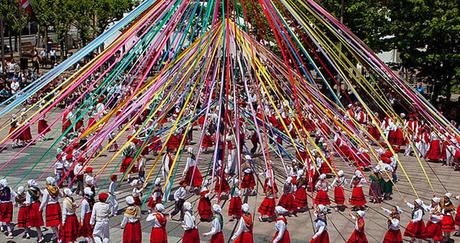
Explore the "Colorful" Origins of This Ancient Spring Tradition (Photo By: Asier Sarasua Aranberri)
We really love Mother Nature here in the Pacific Northwest, and many of us at the workshop have experienced at least one colorful, springy, May Day celebration. It’s hard not to be charmed by the adorable spectacle of happy little children dancing and weaving colorful ribbons around a flower-festooned post. Then again, perhaps your impressions of Maypoles are more historical, taken from classic oil paintings of medieval English peasants or Victorian ladies skipping through ages past. So, what’s the real story behind the Maypole?
The origins of the Maypole are as interwoven and fluid as the dancing it inspires. Early evidence traces the tradition back to Pagan May 1st festivals across Europe. This celebration was called “Beltane” in the regions later known as England and Ireland, and “Walpurgis” in Germanic areas. In some areas, Roman influences also helped shape the celebrations, introducing elements from the spring Festival of Floralia (the goddess of flowers) to these Wiccan and Druidic ceremonies. Maypoles also appear in Scandinavian tradition, with the Swedes observing the custom during their midsummer celebrations.
Many early Maypoles were simply trees stripped to their topmost branches and hung with rings of leaves and flowers. By medieval times, each village would carefully select a Maypole tree for height and straightness, cut it down and smooth it, and erect it in the village square, where it would sometimes remain for years. Carrying on ancient traditions, girls and young women of the villages would dance around the Maypole holding long ribbons or garlands of flowers, weaving in and out around the post and back again. These practices continued to be quite popular, especially in rural Europe, all the way up through the mid-1900s…with a few notable interruptions.

While its popularity has definitely declined, the Maypole still stands in many village greens and schoolyards across the world, and dancers of all ages still kick up their heels to salute it. Hopefully, they've remembered to wear their best Soft Star dancing shoes ;)
Related Posts:
- Why Do We Pinch People and Wear Green on St. Patrick's Day?
- Best Slipper Gift Guide EVER!
- Shoes of the Dead! Celebrating Día de los Muertos in Style

